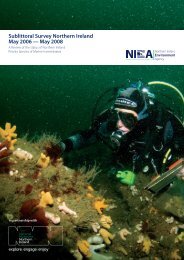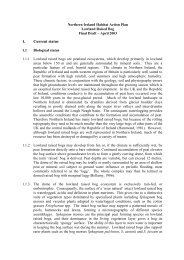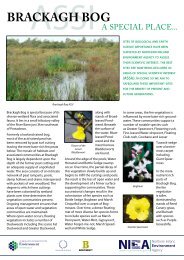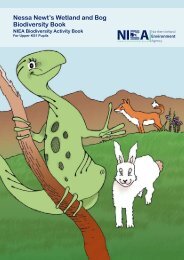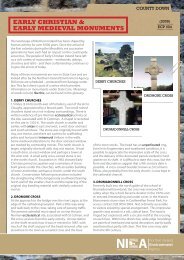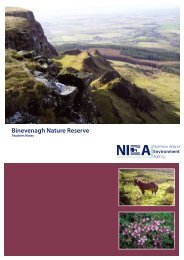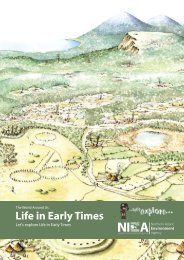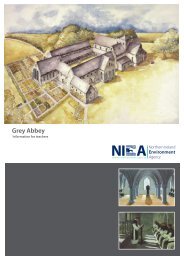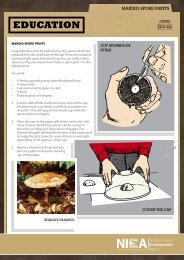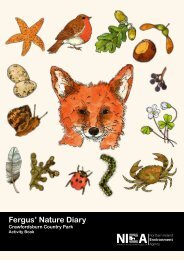Sand Dunes (.PDF 486Kb)
Sand Dunes (.PDF 486Kb)
Sand Dunes (.PDF 486Kb)
Create successful ePaper yourself
Turn your PDF publications into a flip-book with our unique Google optimized e-Paper software.
NATURAL HERITAGE<br />
The sand dunes of Northern Ireland have developed<br />
over the last 5,000 years and are largely derived from<br />
glacial sediment reworked since then by the tides and<br />
wind. Archaeological finds within the dunes have helped<br />
to determine the relative age of the sand dune systems.<br />
Pottery, flints and bone remains excavated from sites on<br />
the Murlough <strong>Dunes</strong> have been identified as belonging to<br />
Neolithic, Bronze Age and Early iron Age cultures. Carbon<br />
dating of fossils found in the dunes on the south side of<br />
the Bann Estuary in Co Londonderry gave an age of 3,300<br />
years BC. These dunes also contain evidence of human<br />
occupation from Neolithic to Medieval times.<br />
DUNE FORMATION<br />
<strong>Sand</strong> dunes are more than just piles of sand: they are also<br />
a complex living system of plants and animals. The dune<br />
structure depends on the development of successive<br />
vegetation communities as well as the purely physical<br />
forces of wind, water and sand.<br />
THE SRAND LINE AND FORE-DUNES<br />
High spring tides and winter storms deposit tidal litter<br />
(eg seaweed and driftwood) along the top of the beach.<br />
The lines of litter provide nutrients, moisture and shelter<br />
for plants like common orache, sea beet, sea rocket and<br />
sea sandwort. These plants form a barrier to wind-blown<br />
particles and start the build-up of sand.<br />
Higher up the beach, out of reach of all but the highest<br />
tides, sand couch and lyme grass trap sand particles and<br />
cause a pioneer zone of mobile fore-dunes to develop.<br />
FIXED YELLOW DUNES<br />
The accumulation of sand accelerates as the highly<br />
specialised marram grass quickly becomes the main<br />
stabilising agent. It can cope with the very dry conditions<br />
and can grow up through a covering of wild-blown sand.<br />
At this stage, the dunes are known as ‘yellow’ dunes<br />
because they are areas of bare sand with a low organic<br />
content. These developing dunes are deficient in water<br />
and plant nutrients and are unstable.<br />
Hardy plants which can survive in this hostile environment<br />
include dune fescue, sand sedge, sea holly and sea<br />
bindweed.<br />
TYPICAL SAND DUNE SYSTEM<br />
HAMMOCK<br />
STABLE GREY DUNES<br />
SAND DUNES<br />
(2009)<br />
...............<br />
NH 009<br />
...............<br />
The new foredunes stop the sand from reaching the ridges<br />
behind which gradually become more stable. Mosses<br />
and lichens colonise the sand between marram tufts and<br />
a raw soil starts to form, allowing more plants to become<br />
established. As organic material becomes incorporated<br />
into the soil, it turns from yellow to grey.<br />
(table overleaf)<br />
Winter Annuals Perennials Nitrogen Fixers<br />
sand cats tail<br />
mouse-ear<br />
chickweed<br />
SHRUB<br />
SAND DUNES<br />
DUNE FIELD<br />
pyramidal<br />
orchard<br />
bird’-foot trefoil<br />
bee orchid white clover<br />
whitlow grass vipers bugloss rest harrow<br />
lambs lettuce blue fleabane kidney vetch<br />
early forget-me-not carline thistle<br />
FORE DUNE<br />
PIONEER DUNE<br />
BEACH<br />
SAND DUNES
MATURE REAR DUNES<br />
The vegetation which develops on the rear dunes varies<br />
depending on the amount of calcium present.<br />
CALCIUM RICH SOILS<br />
Small herbs white clover, hare’s foot, wild thyme,<br />
Lady’s bedstraw, bird’s-foot trefoil,<br />
cat’s ear, mouse-ear hawkweed,<br />
violets, germander speedwell.<br />
Orchids twayblade, pyramidal, common<br />
spotted.<br />
Grasses red fescue, sheep’s fescue, common<br />
bent-grass, meadow grass.<br />
The dunes at Magilligan are built from sands rich in shell<br />
fragments and other calcareous materials and support<br />
species-rich grasslands similar to those found on chalk and<br />
limestone.<br />
Mosses grow between the herbs and grasses to give a<br />
complete ground cover.<br />
The oldest dune ridges at Magilligan tend to show some<br />
soil acidification because rain water eventually leaches out<br />
the calcium salts.<br />
CALCIUM pOOR SOILS<br />
On dunes built up from silica sand, for example at<br />
Murlough, an acidic soil develops as rain water soon<br />
removes what little calcium is present. These dunes<br />
support many plants typical of acid heathland.<br />
Primroses and bluebells flower in spring before the<br />
bracken emerges as only a few plants like twayblades can<br />
tolerate its shade. Dense scrub areas of burnet rose, gorse<br />
and blackthorn are also found.<br />
The very acid conditions on the oldest dunes support a<br />
heath vegetation of ling, bell heather, moss and lichen.<br />
DUNE SLACKS<br />
Underneath most dune systems is a permanent layer of<br />
fresh water floating on top of a denser layer of sea water.<br />
The dune system at Magilligan overlies a layer of<br />
impermeable clays and silts which keeps the water table<br />
high. The hollows between dune ridges may lie very close<br />
to the water table and can flood in winter. These wet areas,<br />
called SLACKS, support a distinctive flora:<br />
The dune pools often support lesser spearwort, bottle<br />
sedge, bogbean and marsh marigold.<br />
Wet slacks do not occur at Murlough because these dunes<br />
were built over shingle which allows water to drain away<br />
easily.<br />
Flowering herbs marsh pennywort, bog pimpernel,<br />
field gentian, grass of parnassus,<br />
meadowsweet, water mint, yellow<br />
iris.<br />
Orchids marsh helleborine, northern marsh<br />
orchid.<br />
Grasses sheep’s fescue, white bent, heath<br />
grass.<br />
Sedges glaucous, carnation, sand.<br />
Non-flowering variegated horsetail, adder’s tongue<br />
fern, mosses (form a thick layer in<br />
wettest areas).<br />
Shrubs creeping willow.<br />
INTERTEBRATES<br />
The rich variety of plants and nectar-bearing flowers like<br />
birds-foot trefoil and wild thyme attract many butterflies<br />
including the dark green fritillary, grayling, common blue,<br />
meadow brown and ringlet.<br />
The six-spot burnett, a red and black day flying moth,<br />
prefers the seaward areas of the dunes where it feeds on<br />
ragwort. This yellow flower is also food for the yellow and<br />
black striped larvae of the cinnabar moth.<br />
Other invertebrates such as bees, wasps, beetles, flies and<br />
spiders are numerous on the dunes. Snails are common<br />
on the calcareous sand at Magilligan, but are restricted to<br />
a narrow coastal strip at Murlough because the soil is short<br />
of calcium which snails require for their shells.<br />
COMMON BLUE<br />
BEE
BIRDS<br />
The short dune vegetation attracts ground-nesting species<br />
such as skylarks and meadow pipits. Areas of scrub, are<br />
used as nesting sites by woodland species, like willow<br />
warbler, chaffinch, blackbird, robin, dunnock and wren.<br />
Kestrels and sparrowhawks hunt over the dunes by day for<br />
small mammals and birds, while long-eared owls hunt at<br />
night for mice and shrews.<br />
Waders often use the dune sands as roosts between high<br />
tides when their feeding grounds are submerged. Many<br />
species also use the dunes and slacks as nesting sites, such<br />
as ringed plover, oystercatchers, snip and dunlin.<br />
MAMMALS<br />
The mammals that live on sand dunes are mostly nocturnal<br />
and can be difficult to see, but footprints and droppings<br />
may advertise their presence. Stoats and foxes visit dunes<br />
to hunt for wood mice, pygmy shrews and rabbits. Badgers<br />
sometimes dig setts in the dunes, but they generally prefer<br />
the cover provided by areas of scrub.<br />
Rabbits were introduced to warrens on many sand dune<br />
systems for their meat and pelts. They became numerous<br />
until myxomatosis destroyed large numbers in the 1950s.<br />
Today, numbers are gradually increasing as rabbits appear<br />
to be building up immunity to this disease.<br />
Common seals haul out on the sands furthest away from<br />
visitor hotspots.<br />
THREATS<br />
•<br />
•<br />
•<br />
•<br />
•<br />
Excessive trampling, use of vehicles and rabbit burrows<br />
can all break up vegetation and expose bare sand to<br />
the wind.<br />
Trees planted to stabilise sand have destroyed the<br />
typical dune vegetation.<br />
Drainage, water extraction and afforestation can lower<br />
the fresh water table and cause species – rich slacks to<br />
dry out.<br />
<strong>Sand</strong> mining or coastal defence works can reduce the<br />
amount of sand reaching the dunes. Eventually, the<br />
dune system may disappear.<br />
The siting of industries, housing and caravan parks on<br />
dunes causes total habitat destruction. Golf courses<br />
may reduce species variety, but the roughs can provide<br />
a haven for many dune plants and animals.<br />
MANAGEMENT<br />
<strong>Sand</strong> dunes are special habitats that provide refuges for<br />
many unique plants and animals. They are also important<br />
as a first line of defence: they protect inland<br />
areas from erosion and flooding, and prevent the<br />
contamination of ground water and farmland by salt water.<br />
If they are to continue to provide areas for the enjoyment<br />
of wildlife, for passive recreation and to fulfil their coastal<br />
defence function, we shall need to take great care to avoid<br />
their destruction.<br />
•<br />
•<br />
•<br />
•<br />
•<br />
Human impact on dunes can be reduced by fencing<br />
off sensitive areas and by providing surfaced paths<br />
between car parks and the beach.<br />
Damaged areas of bare sand can be repaired by<br />
planting marram grass and sand couch grass.<br />
Grazing and mowing help to maintain species diversity<br />
by keeping coarse grasses and tree seedlings under<br />
control.<br />
Invasive species like sea buckthorn, sycamore and Scots<br />
pine can be controlled by uprooting, but progress is<br />
often painfully slow.<br />
When visiting sand dunes, keep to the proper paths<br />
and the beach. Do not walk over the dunes or pull<br />
plants because this can destroy the fragile surface<br />
vegetation and allow erosion to start.<br />
SAND DUNES TO VISIT<br />
Murlough National Nature Reserve, on the A2 between<br />
Newcastle and Dundrum, Co Down. Owned and managed<br />
by the National Trust.<br />
Magilligan Point National Nature Reserve, at the entrance to<br />
Lough Foyle, Co Londonderry.<br />
Portstewart Strand and dunes. Owned and managed by<br />
the National Trust.<br />
CHAFFINCH<br />
STOAT
SAND DUNES<br />
REFERENCES<br />
The Coastline - Barnes, RSK. (1977).<br />
Publisher: John Wiley and Sons, Chichester.<br />
ISBN 0 471 994707.<br />
<strong>Sand</strong> <strong>Dunes</strong> and their Management -<br />
Doody, J P. (1985).<br />
Publisher: Joint Nature Conservation Committee,<br />
Peterborough. ISBN 0 86139 324 4.<br />
<strong>Sand</strong> <strong>Dunes</strong> Inventory of Europe -<br />
Doody, J P. (1991).<br />
Publisher: Joint Nature Conservation Committee,<br />
Peterborough. ISBN 1 873701 07 1.<br />
The Conservation of <strong>Sand</strong> <strong>Dunes</strong> -<br />
Nature Conservancy Council. (1986).<br />
Publisher: Nature Conservancy Council, Peterborough.<br />
ISBN 0 86139 1896.<br />
A Guide to the <strong>Sand</strong> <strong>Dunes</strong> of Ireland -<br />
Quigley, M B. (1991). Publisher: European Union for Dune<br />
Conservation and Coastal Management, Dublin. ISBN 0<br />
9517779 04.<br />
Coast Dune Management Guide -<br />
Ranwell, D S. (1986). Publisher: Institute of Terrestrial<br />
Ecology, Huntingdon<br />
Our aim is to protect, conserve and promote<br />
the natural and built environment for the<br />
benefit of present and future generations.<br />
Northern Ireland Environment Agency<br />
Klondyke Building<br />
Cromac Avenue<br />
Gasworks Business Park<br />
Belfast BT7 2JA<br />
T. 0845 302 0008<br />
www.ni-environment.gov.uk




